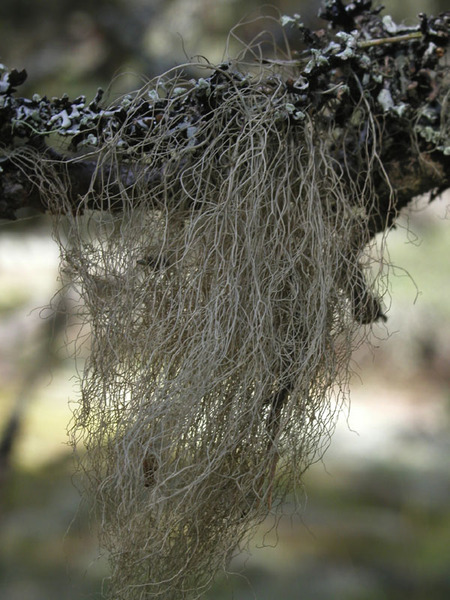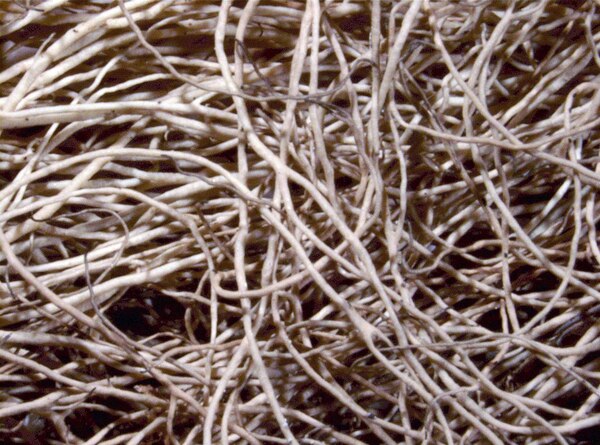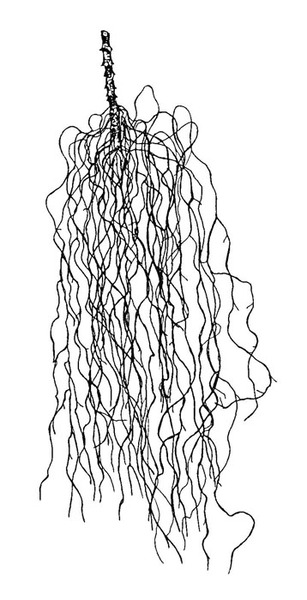Bryoria capillaris (Ach.) Brodo & D. Hawksw.
Opera Bot., 42: 115, 1977. Basionym: Parmelia jubata var. capillaris Ach. - Meth. Lich.: 273, 1803.
Synonyms: Alectoria cana (Ach.) Leight.; Alectoria capillaris (Ach.) Cromb.; Alectoria fuscidula auct.; Alectoria implexa auct. p.p.; Alectoria implexa var. cana (Ach.) Flagey; Alectoria jubata f. rufescens Anzi; Alectoria setacea (Ach.) Motyka; Bryopogon capillaris (Ach.) Bystrek; Bryoria setacea (Ach.) Brodo & D. Hawksw.
Distribution: N - Frl (Tretiach & Molaro 2007), Ven (Nascimbene & Caniglia 1997, 2002c, 2003c, Caniglia & al. 1999, Nascimbene & al. 2006e, Nascimbene 2008c, 2011), TAA (Caniglia & al. 2002, Nascimbene & Caniglia 2002c, Nascimbene 2003, 2006b, 2006c, 2006e, 2008b, De Marco & al. 2003, Nascimbene & al. 2009, 2007b, 2010, 2022, Obermayer 2013, Nimis & al. 2015), Lomb, Piem (Morisi & Sereno 1995, Isocrono & al. 2004), VA (Piervittori & Isocrono 1997, 1999, Matteucci & al. 2008), Emil (Dalle Vedove & al. 2002, Fariselli & al. 2020), Lig. C - Tosc (Benesperi & al. 2007), Umb (Ravera 1998, Ravera & al. 2006), Laz, Abr, Sar (Zedda 1995, 2002, 2002b). S - Camp (Aprile & al. 2003b), Pugl (Nimis & Tretiach 1999), Bas (Potenza 2006, Potenza & Fascetti 2012), Cal (Puntillo & Vezda 1994, Puntillo 1995, 1996, Stofer 2006), Si.
Description: Thallus fruticose, filamentous, attached by a basal holdfast, long-pendent, soft, to 30 cm long, whitish grey to brownish grey, very rarely dark brown in sun-exposed morphs, usually without a main branch, irregularly branching with acute angles, the branches terete to flattened at axils, to 0.5 mm thick. Soralia absent to usually abundant, small, tuberculate, with farinose soredia. Pseudocyphellae sparse, fusiform, usually inconspicuous; medulla white, compact. Apothecia extremely rare (never observed in Italian material), zeorine, with a brown disc, to 1-2 mm across. Asci 8-spored, Lecanora-type. Ascospores 1-celled, hyaline, subglobose to ellipsoid, 5-9 x 4-6 μm. Photobiont chlorococcoid. Spot tests: cortex and medulla K+ yellow, C+ red or C-, KC+ red, P+ yellow; soralia P+ red; apothecia P+ yellow. Chemistry: barbatolic acid, sometimes alectorialic acid and atranorin in cortex; fumarprotocetraric acid in soralia; psoromic acid in apothecia. Note: a temperate to boreal-montane, circumpolar lichen, with optimum in montane humid Fagus-Abies forests, mostly on twigs, but also on boles of isolated trees in areas with frequent fog. The study of Boluda et al. (2019) revealed a strong mismatch between phenotypes and genotypes in Bryoria sect. Implexae, which brought to the reduction from 11 to 4 species. All European species (B. capillaris, B. chalybeiformis, B. implexa, B. lanestris, B. kuemmerleana, and B. subcana) should be considered as synonyms of B. fuscescens. Due to their chemical and morphological differences, I still provisionally maintain these taxa as separate species.
Growth form: Fruticose filamentous
Substrata: bark
Photobiont: green algae other than Trentepohlia
Reproductive strategy: mainly asexual, by soredia, or soredia-like structures (e.g. blastidia)
Most common in areas with a humid-warm climate (e.g. most of Tyrrenian Italy)
Commonnes-rarity: (info)
Alpine belt: absent
Subalpine belt: rare
Oromediterranean belt: absent
Montane belt: rather rare
Submediterranean belt: extremely rare
Padanian area: absent
Humid submediterranean belt: extremely rare
Humid mediterranean belt: absent
Dry mediterranean belt: absent
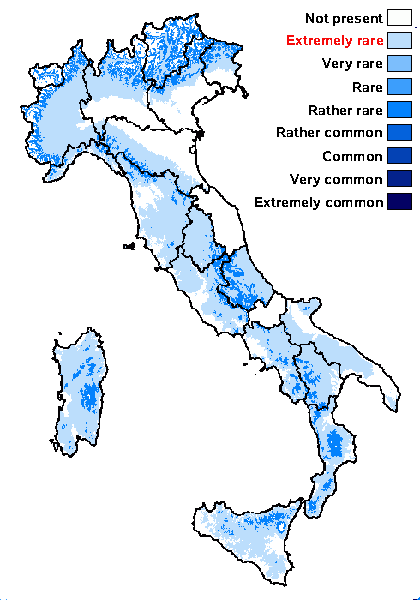
Predictive model
Herbarium samples
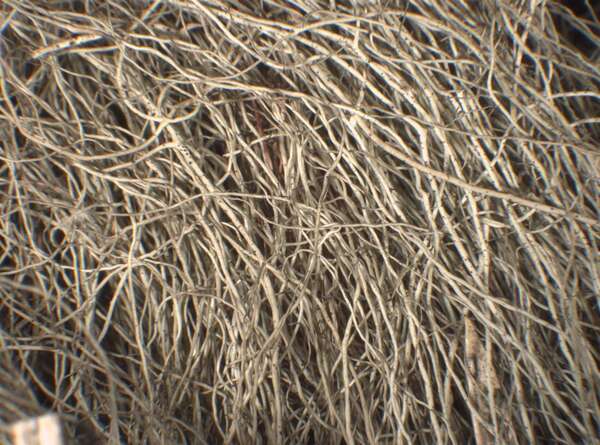

P.L. Nimis; Owner: Department of Life Sciences, University of Trieste
Herbarium: TSB (35714)
2003/01/22
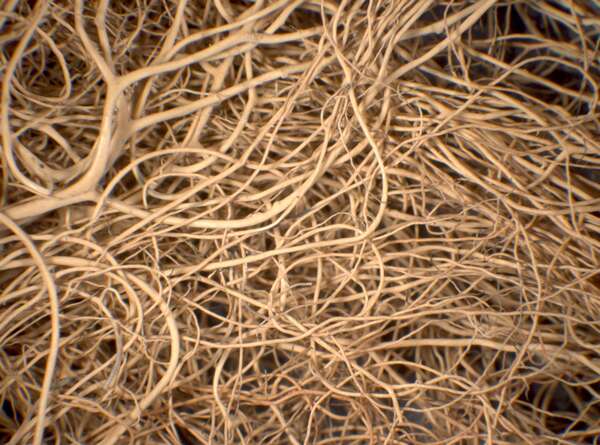

P.L. Nimis; Owner: Department of Life Sciences, University of Trieste
Herbarium: TSB (1821)
2002/02/24
old, pinkish herbarium specimen
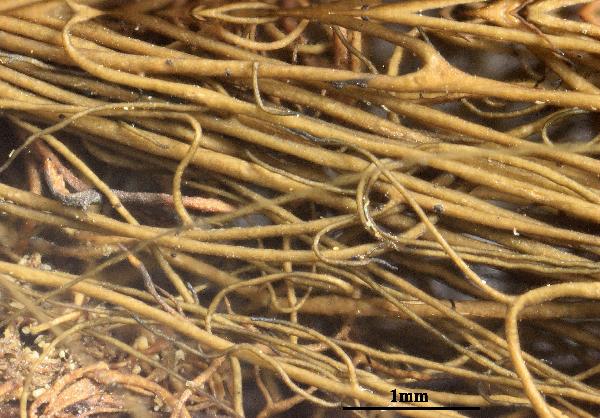

Felix Schumm - CC BY-SA 4.0
[VZR332], USA, Washington, Spokane County. In summo montis
Spokane, ad septentriones et orientem ab urbe Spokane, 1790 m. Ad
ramos emortuos Abies lasiocarpae. Leg. W. L. Culberson (no.2388),
9.08.1996. -Annot.: Barbatolic acid (trace) and an unidetified triterpene
3
by TLC, anal. J. Johnson & C. F. Culberson. EX A. VEZDA: LICHENES
RARIORES EXSICCATI NR. 332.
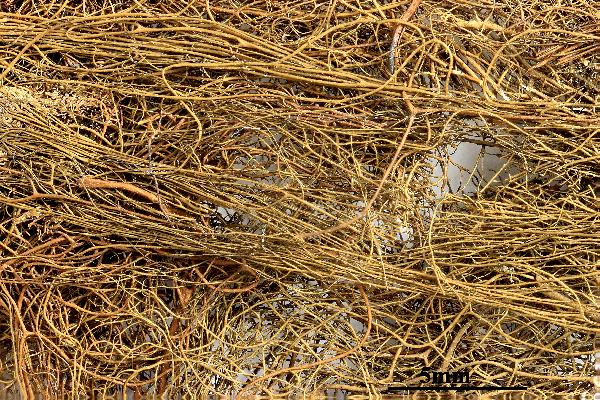

Felix Schumm - CC BY-SA 4.0
[VZR332], USA, Washington, Spokane County. In summo montis
Spokane, ad septentriones et orientem ab urbe Spokane, 1790 m. Ad
ramos emortuos Abies lasiocarpae. Leg. W. L. Culberson (no.2388),
9.08.1996. -Annot.: Barbatolic acid (trace) and an unidetified triterpene
3
by TLC, anal. J. Johnson & C. F. Culberson. EX A. VEZDA: LICHENES
RARIORES EXSICCATI NR. 332.
Growth form: Fruticose filamentous
Substrata: bark
Photobiont: green algae other than Trentepohlia
Reproductive strategy: mainly asexual, by soredia, or soredia-like structures (e.g. blastidia)
Most common in areas with a humid-warm climate (e.g. most of Tyrrenian Italy)
Commonnes-rarity: (info)
Alpine belt: absent
Subalpine belt: rare
Oromediterranean belt: absent
Montane belt: rather rare
Submediterranean belt: extremely rare
Padanian area: absent
Humid submediterranean belt: extremely rare
Humid mediterranean belt: absent
Dry mediterranean belt: absent

Predictive model
| Herbarium samples |


P.L. Nimis; Owner: Department of Life Sciences, University of Trieste
Herbarium: TSB (35714)
2003/01/22


P.L. Nimis; Owner: Department of Life Sciences, University of Trieste
Herbarium: TSB (1821)
2002/02/24
old, pinkish herbarium specimen


Felix Schumm - CC BY-SA 4.0
[VZR332], USA, Washington, Spokane County. In summo montis Spokane, ad septentriones et orientem ab urbe Spokane, 1790 m. Ad ramos emortuos Abies lasiocarpae. Leg. W. L. Culberson (no.2388), 9.08.1996. -Annot.: Barbatolic acid (trace) and an unidetified triterpene 3 by TLC, anal. J. Johnson & C. F. Culberson. EX A. VEZDA: LICHENES RARIORES EXSICCATI NR. 332.


 INDEX FUNGORUM
INDEX FUNGORUM
 GBIF
GBIF
 DOLICHENS
DOLICHENS
